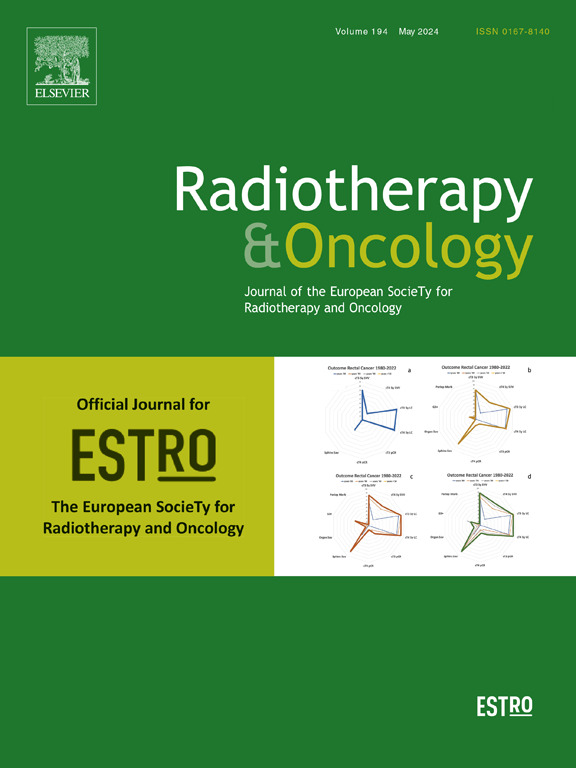Multi-contrast 4DMR via MR multitasking: Early clinical experience and implication for liver stereotactic body radiation therapy
IF 4.9
1区 医学
Q1 ONCOLOGY
引用次数: 0
Abstract
Background
Liver tumors have low contrast on 4DCT. A novel Multitasking (MT)MR imaging technique has been implemented on the MR simulator, providing both T1 and T2-weighted 4DMR images in a single 8-min free-breathing scan for better tumor delineation and motion evaluation. This study reports our early clinical experience of MTMR regarding tumor visibility, motion characteristics, and resultant dosimetry compared to post-contrast 4DCT for liver SBRT.
Methods
Phantom motion validation was performed. Tumor contrast-to-noise ratio (CNR) and motion were analyzed in 54 patients. Replanning for 17 patients (21 tumor volumes) was performed, and planning target volume receiving greater than 90% of the prescription (PTV_V90) was compared based on optimized dose distributions for each 4D dataset-derived PTV.
Results
Phantom motions in both 4DCT and MTMR datasets were within <1.8 mm of the programmed ground truth. The absolute CNR of MTMR-T1w and MTMR-T2w were significantly greater than post-contrast 4DCT. Tumor superior-inferior motions were significantly greater in MTMR than in 4DCT, while PTV volumes were not significantly different between the two 4D datasets. The PTV_V90 calculated from individual MTMR-T1w and 4DCT optimized plans were similar. However, a statistically significant 5 % reduction of PTV_V90 was observed when the optimized PTV_MTMR dose was superimposed on the respective PTV_4DCT, or vice versa for the re-planning patient cohort.
Conclusion
This study demonstrates that the MTMR sequence offers superior tumor visualization and detects greater superior-inferior motion compared to 4DCT, enhancing the precision of radiotherapy planning for liver SBRT. While both imaging methods achieve comparable target volume coverage with individually optimized plans, discrepancies in tumor positioning lead to reduced coverage when plans are cross-applied, highlighting the importance of motion assessment accuracy. MTMR’s ability to provide multiple contrast-weighted images in a single scan addresses limitations of traditional 4DCT and multi-sequence MR protocols, particularly for patients unable to receive contrast.
磁共振多任务多重对比4DMR:早期临床经验及其对肝脏立体定向放射治疗的启示。
背景:肝脏肿瘤在4DCT上呈低对比度。一种新的多任务(MT)磁共振成像技术已经在磁共振模拟器上实现,在一次8分钟的自由呼吸扫描中提供T1和t2加权的4DMR图像,以更好地描绘肿瘤和运动评估。本研究报告了MTMR在肝脏SBRT的肿瘤可见性、运动特征和由此产生的剂量测定方面的早期临床经验,并与对比后的4DCT进行了比较。方法:幻影运动验证。对54例患者的肿瘤噪比(CNR)及运动情况进行分析。对17例患者(21个肿瘤体积)进行了重新规划,并根据每个4D数据集衍生的PTV的优化剂量分布,比较接受大于90%处方的计划靶体积(PTV_V90)。结论:本研究表明,与4DCT相比,MTMR序列提供了更好的肿瘤可视化,检测到更多的上下级运动,提高了肝脏SBRT放疗计划的准确性。虽然两种成像方法都可以通过单独优化的方案实现相当的靶体积覆盖,但当交叉应用方案时,肿瘤定位的差异会导致覆盖率降低,这突出了运动评估准确性的重要性。MTMR在一次扫描中提供多个对比度加权图像的能力解决了传统4DCT和多序列MR协议的局限性,特别是对于无法接受对比度的患者。
本文章由计算机程序翻译,如有差异,请以英文原文为准。
求助全文
约1分钟内获得全文
求助全文
来源期刊

Radiotherapy and Oncology
医学-核医学
CiteScore
10.30
自引率
10.50%
发文量
2445
审稿时长
45 days
期刊介绍:
Radiotherapy and Oncology publishes papers describing original research as well as review articles. It covers areas of interest relating to radiation oncology. This includes: clinical radiotherapy, combined modality treatment, translational studies, epidemiological outcomes, imaging, dosimetry, and radiation therapy planning, experimental work in radiobiology, chemobiology, hyperthermia and tumour biology, as well as data science in radiation oncology and physics aspects relevant to oncology.Papers on more general aspects of interest to the radiation oncologist including chemotherapy, surgery and immunology are also published.
 求助内容:
求助内容: 应助结果提醒方式:
应助结果提醒方式:


